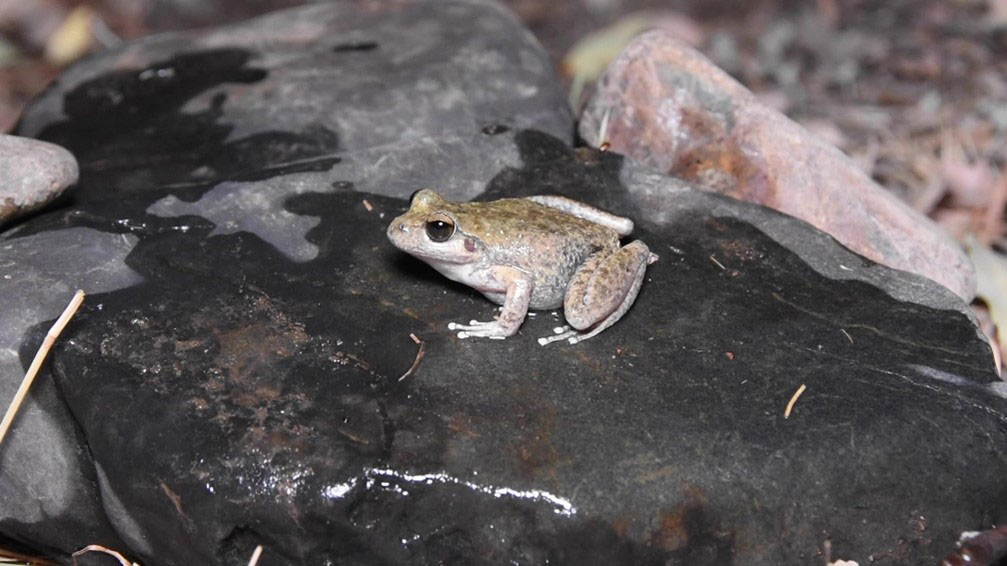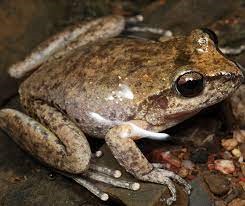Fish, frogs, flora and fresh flowing water
This 10-year project, now in its 8th year, has increased the long-term viability and security of 7 threatened species that rely on riparian environments in the central and south-west slopes region of NSW. This includes:
- two SoS site-managed frogs (Booroolong Frog and Yellow-spotted Bell Frog)
- one EPBC listed partnership species (Spotted Tree Frog)
- one SoS site-managed plant (Tumut Grevillea)
- two threatened fish (Macquarie Perch and Southern Pygmy Perch)
- one threatened crayfish (Murray Crayfish).
This project also increased the extent, connectivity, and value of an endangered ecological community (Box-Gum woodland) and benefited a range of threatened woodland bird species.
What threatened species and parts of the environment are being protected?
There have been 7 key locations throughout NSW selected for threat abatement activities and habitat restoration and rehabilitation.
The key threats targeted in this project were:
- the amphibian chytrid fungus
- weed infestation (particularly blackberry and willow)
- erosion caused by inappropriate stock management and feral pigs.

Figure 1. Map of Fish, Frogs, Flora and Fresh Flowing Water Program management sites.
Project funding
This project has been funded for 7 years by the Environmental Trust SoS grant program, with a three-year follow up in-kind monitoring program. The project partners include:
Agency | Roles and responsibilities |
|---|---|
Central Tablelands Local Land Services |
|
South East Local Land Services |
|
Riverina Local Land Services |
|
Murray Local Land Services |
|
Office of Environment and Heritage ROG Regions:
|
|
Department of Primary Industries and Regional Development |
|
Taronga |
|
National Parks and Wildlife Services |
|
How is Local Land Services protecting threatened species?
This project has demonstrated the capacity to combine primary production with biodiversity conservation through on-ground actions that enhance and protect riparian environments in the agricultural landscape. The project is excelling due to extensive baseline research, co-occurring threatened species and common threats, and the extensive community engagement that has been undertaken by Local Land Services, Office of Environment and Heritage, and Department of Primary Industries and Regional Development over the past 25 years at the target sites.
- Feral species control and eradication (both flora and fauna)
- Ecological monitoring
- Community engagement
- Captive breeding and translocation (Taronga Zoo to selected release sites)
- Habitat restoration.
Local Land Services is undertaking aerial pest species control and eradication in conjunction with National Parks and Wildlife Services. In different regions there are specific focuses, some with reducing feral pig numbers as they are known to degrade riverine systems with their bioturbation activities.
In the Central Tablelands region, a drone will be used to take follow up footage of where works were initially undertaken. This is so we can compare the sites with the before and after footage to see the improvements from the original project works.
October 2022 saw the release of the Sewell’s Creek Local Area Management Plan for the Booroolong Frog. This plan is a voluntary contribution by local landholders to manage their environment for the benefit of the local Booroolong Frog population. This will also include some flume restoration works undertaken by Central Tablelands Local Land Services to improve water quality in Booroolong habitat in Essington Forest.
In May 2023, the focus will be on World Environment Day where the local Heritage Schools from the Central Tablelands are invited to the Abercrombie Caves to hear from speakers about endangered species and what we can do for them.
Local Land Services will also assist the Department of Primary Industries and Regional Development and National Parks and Wildlife Services with some monitoring of the target species throughout NSW.
How to get involved in the project
- Attending the Local Land Services hosted SoS events and any other relevant events held by stakeholders such as Department of Primary Industries and Regional Developments, Sustainable Farms and Landcare.
- Applying for funding in the Healthy Landscapes Stream Protection project.
- Feral species eradication.
- Restoration and rehabilitation of on-property riparian areas.
- Species monitoring.
For more information on the project
Contact Katie McPherson, Senior Officer – Natural Resource Management on 0460 897 275 or kate.a.mcpherson@lls.nsw.gov.au
Information collected during the monitoring of several of these species can be found in the SoS Species database.

Figure 2. Booroolong Frog. Photo credit Taronga Zoo.

Figure 3. Booroolong Frog. Photo credit NSW Government.